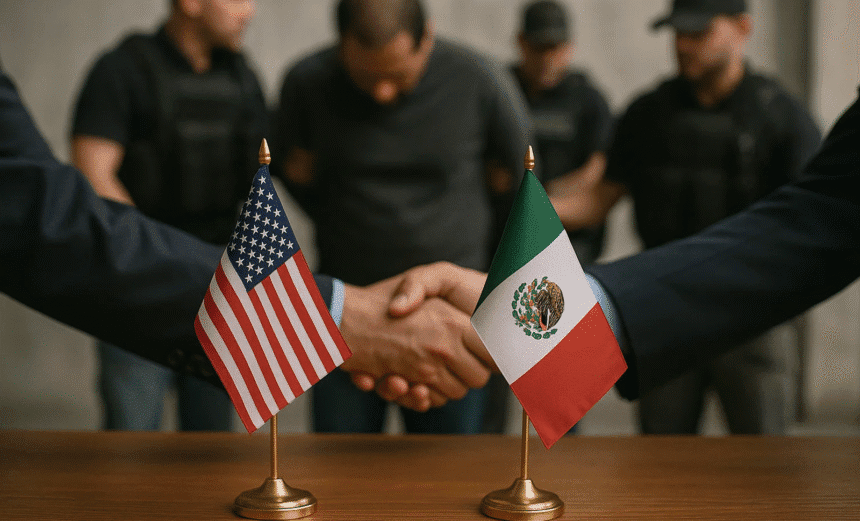On August 12, 2025, Mexico transferred 26 alleged cartel figures to the custody of the United States in one of the largest handovers of criminal suspects in recent years. The operation, carried out under a special bilateral security agreement, bypassed Mexico’s traditional judicial extradition procedures and relied instead on the government’s national security framework. The transfer, coordinated by Mexico’s Security Ministry with support from the armed forces, was presented as a bold step to reinforce public safety and strengthen bilateral cooperation with Washington.
Among those handed over were high-profile figures connected to some of the most notorious drug cartels. The most prominent was Abigael González Valencia, alias El Cuini, a leader of the Los Cuinis group closely allied with the Jalisco New Generation Cartel (CJNG). González Valencia is the brother-in-law of CJNG’s top leader, Nemesio “El Mencho” Oseguera Cervantes, one of the most wanted men in the hemisphere. Another detainee was Roberto Salazar, wanted in the U.S. for his alleged role in the 2008 killing of a Los Angeles County sheriff’s deputy. The remaining individuals are said to have ties to the Sinaloa Cartel, Los Zetas, and other violent criminal groups that have dominated Mexico’s drug trade for decades.
This was not the first such operation. In February 2025, Mexico had already transferred 29 cartel suspects to U.S. authorities, including the infamous drug trafficker Rafael Caro Quintero. Together, the two rounds of transfers underscore the extent to which Mexico’s new administration is willing to deepen cooperation with Washington in tackling transnational organized crime. In both cases, U.S. prosecutors gave a crucial assurance: none of the transferred suspects would face the death penalty, a legal and ethical condition Mexico requires to respect its constitutional and human rights obligations.
For the United States, the transfers represent a breakthrough. Washington has long complained that cartel leaders, even when detained in Mexico, continued to run operations from inside prison walls, ordering killings and overseeing drug shipments. By bringing them to U.S. soil, authorities believe they can limit such influence and prosecute them in federal courts under charges ranging from drug trafficking to homicide and organized crime. U.S. Attorney General Pam Bondi hailed the move as “a decisive step in dismantling cartel networks that poison American communities.”
In Mexico, however, the decision sparked mixed reactions. President Claudia Sheinbaum defended the transfers as a matter of national security, rejecting claims that they were made under U.S. pressure. “This is not about submission,” she stated, “it is about protecting our country and ensuring that these individuals cannot continue to operate with impunity.” Supporters argue the measure prevents cartel bosses from exploiting weak points in Mexico’s penal system.
However, critics note the timing of the handovers, which occurred shortly after tense negotiations between Sheinbaum’s government and the Trump administration over tariffs. Washington had threatened new trade penalties, only to postpone them after the security agreement was announced. Observers suggest the cartel transfers may have been used as a bargaining chip in economic talks, raising questions about whether justice is being shaped by political leverage. The bypassing of Mexico’s judicial extradition process has also raised concerns among legal analysts, who warn that this practice could erode the country’s judicial sovereignty and set a precedent for executive overreach.
Still, the operation marks a new phase in the bilateral relationship. It highlights the intertwined nature of security and politics between Mexico and the United States, where cartel violence, drug trafficking, and cross-border flows of fentanyl dominate the agenda. While the U.S. prepares prosecutions and Mexican authorities plan further press briefings, the long-term impact remains uncertain. Analysts caution that cartels may adapt by restructuring leadership, escalating violence, or finding alternative routes for smuggling. The fight, they say, is far from over.
For now, the handover of 26 cartel suspects symbolizes both a victory in law enforcement cooperation and a reminder of the delicate balance between sovereignty, diplomacy, and domestic security. Whether seen as a triumph against organized crime or a political concession to Washington, the move underscores the high stakes at play in North America’s ongoing war against cartels.














